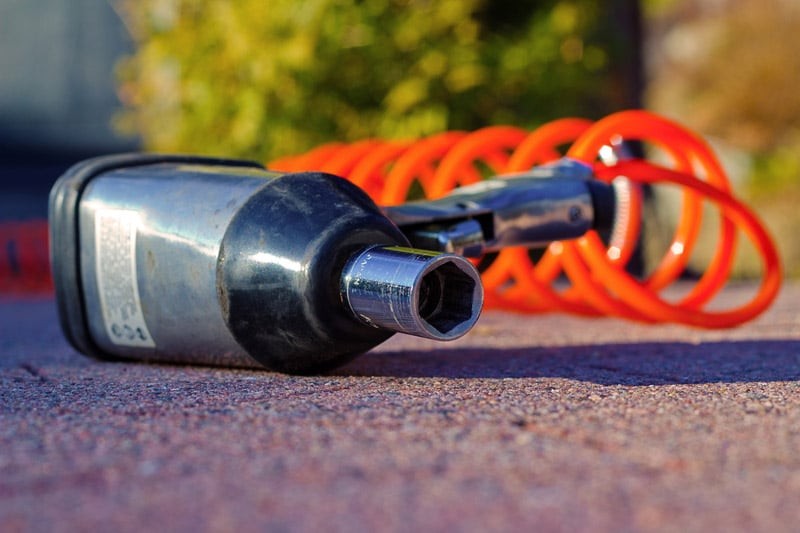It’s a common misconception that a bigger air compressor is automatically better, especially when it comes to powering your car tools. However, the physical size of an air compressor isn’t the primary factor determining its effectiveness for your pneumatic tools. What truly matters is understanding your tools’ air requirements and matching them with the right air compressor output.
 air tools for car repair
air tools for car repair
Many assume that a large air compressor equates to high power, but this isn’t always the case. Some bulky compressors might have surprisingly low air output, while conversely, compact models can deliver substantial power. Leading manufacturers invest significantly in research and development to create air compressors that are both lightweight and powerful. Therefore, judging an air compressor’s capability based solely on its size can be misleading.
Understanding CFM for Air Compressor Sizing
Instead of focusing on physical dimensions, the key metric to consider when sizing an air compressor for your car tools is its air delivery rate, measured in Cubic Feet per Minute (CFM). For most automotive air tools, the required CFM typically falls within the range of 10 to 110 CFM.
Air compressors with lower CFM ratings are suitable for tasks like inflating car tires and operating smaller air tools such as airbrushes, nail guns, or detail sanders. On the other hand, higher CFM compressors are designed for more demanding applications, including running larger impact wrenches, pneumatic drills, and other heavy-duty automotive tools.
To pinpoint the ideal air compressor size for your needs, follow these steps:
- Identify the CFM Requirement of Your Most Demanding Tool: Check the manufacturer’s specifications for the air tool that requires the highest CFM. This is often your impact wrench or a similar power tool.
- Consider Duty Cycle: Note if the CFM rating of your tool assumes a 100% duty cycle. Many tools are rated assuming intermittent use (e.g., 50-60% duty cycle). If you plan to use your tools continuously, you’ll need an air compressor with a higher CFM output to avoid interruptions.
- Account for Simultaneous Tool Use: If you frequently use multiple air tools at the same time, sum up their individual CFM requirements to determine the total CFM needed from your air compressor.
Once you’ve calculated the CFM demand of your car tools, you’ll have a clear picture of the air compressor power you need. Aim for an air compressor that adequately meets your CFM requirements without significantly exceeding them, as oversizing can lead to unnecessary expense and space consumption.
The Role of Air Receiver Tanks in Air Compressor Systems
Air receiver tanks are valuable additions to air compressor systems, as they store compressed air and provide a buffer for short-term, high-demand air tool usage. While essential for reciprocating air compressors, rotary screw compressors, known for their 100% duty cycle, often operate efficiently without tanks.
However, even with rotary screw compressors, incorporating an air receiver tank can sometimes allow you to choose a slightly lower CFM model. For instance, if your tools require 45 CFM, and you’re choosing between a 40 CFM and a 60 CFM compressor, opting for the 40 CFM compressor paired with an appropriately sized air receiver tank can be a more economical solution. To delve deeper into air receiver tank sizing, numerous resources are available online, offering detailed guidance on selecting the right tank capacity for your specific needs.
Air Tool CFM Consumption Guide
The most accurate way to determine your air power needs is to consult the specifications of each of your air tools. However, for a quick estimate, a general air tool consumption guide can be incredibly helpful. These guides provide typical CFM ranges for various types of air tools, allowing you to quickly gauge your approximate requirements.
| Air Tool Category | CFM Range (at 90 PSI) | Examples |
|---|---|---|
| Low CFM (0-5 CFM) | 0-5 CFM | Airbrushes, Nail Guns, Detail Sanders |
| Medium CFM (5-10 CFM) | 5-10 CFM | Ratchet Wrenches, Impact Wrenches (small) |
| Moderate CFM (10-20 CFM) | 10-20 CFM | Angle Grinders, Air Hammers, Spray Guns |
| High CFM (20+ CFM) | 20+ CFM | Impact Wrenches (large), Pneumatic Drills |
Note: CFM values are approximate and can vary based on tool model and manufacturer. Always check the tool’s specifications for precise requirements.
Selecting the Right Air Compressor Type for Car Tools
After determining your CFM requirements, the next step is to explore the different types of air compressors available. Several factors come into play when choosing the best air compressor for your car tools:
- Rotary Screw vs. Reciprocating Compressors: Rotary screw compressors are generally quieter, more efficient for continuous use, and require less maintenance, while reciprocating compressors are often more affordable and suitable for intermittent use.
- Portability: Consider whether you need a portable or stationary air compressor. Portable options include handheld, wheeled, and tow-behind models, offering flexibility for mobile use. Stationary compressors are designed for fixed locations in garages or workshops.
- Power Source: Air compressors can be powered by electricity, gasoline, or diesel. Electric compressors are ideal for indoor use and quieter operation, while gas and diesel models offer greater portability and power for demanding applications.
- Multi-Power Systems: For comprehensive automotive service needs, explore multi-power systems that combine air compression with other functionalities like generators and welders, offering versatility in a single unit.
Conducting thorough research and considering your specific needs will guide you to the ideal air compressor type. Numerous resources are available online, including product finders, buying guides, and comparisons of different air compressor technologies, to assist you in making an informed decision. By focusing on CFM requirements and understanding the various types of air compressors, you can confidently choose the perfect air compressor to power your car tools effectively and efficiently.
